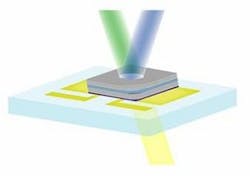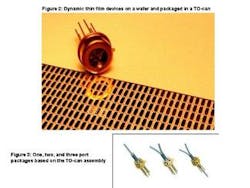Low-cost packaging for dynamic optical components
The co-axial Transistor Outline "can" or "TO-can" hermetically sealed package can be leveraged for its simplicity in the design of innovative, low-cost dynamic optical components.
By MARK LOURIE
Aegis Semiconductor
There is a flurry of activity in the dynamic optical component space as established vendors and start-ups look for new ways to fulfill a growing demand. In many cases, optical bench experiments are boiled down into product-like enclosures in the rush to meet a skyrocketing market. But in reality, significant portions of cost, size, and reliability problems are tied up in the packaging itself. Sub-micron alignments, lack of hermetic enclosures, organic materials near the optical path, and moving parts can help demonstrate exotic optical functions but turn out to be unacceptable when transferred to manufacturing or unreliable when deployed in the field. Systems engineers will continue to wish for the best of both worlds: new optical functionality, but with well-known materials and compact, commodity packaging.
Using well-known packaging in a new way
Today's reality is that the fiber-optic component market is still a "cottage industry." Successful product development strategies need to adjust accordingly. Some of the old characteristics of the fiber-optic industry are now more than ever critical criteria for survival. These criteria include rapid time to market together with flexible customization capability--but without the burden of large capital investments.
As a result, a successful packaging strategy might focus on the development of optical chips that can be housed in commodity optical packaging platforms that require little capital investment for production lines. In order to make use of commodity optical packaging, however, a new class of dynamic optical components must be designed for wide tolerances in alignment and simple assembly.
One of the most mature, lowest cost, most compact electronic and fiber-optic hermetically sealed packages is the co-axial Transistor Outline "can" or "TO-can." The fiber-optic industry has an extensive familiarity with this package, which has been used to house many tens of millions of Indium Gallium Arsenide (InGaAs) detectors for telecommunications and data-communications receivers. As a result, the TO-can, perhaps the most common hermetic fiber-optic package, can be leveraged for its simplicity in the design of innovative, low-cost dynamic optical components.
TO-can assembly processes are well known and all the equipment is already in place at multiple contract houses worldwide. Electrical and optical chips are mounted on a TO-header. Chip placement can be done manually in low volumes or by automation for high volumes. Both are done by simple operation requiring only very coarse alignment. Electrical components are wire-bonded to the pins of the header. The entire TO-header assembly is hermetically sealed with a TO-cap using a resistance weld.
Dynamic optical components for wide tolerance packaging
The integration of semiconductor thin films into optical interference coatings provides a new class of low-cost, compact photonic devices. Through the well-known physical properties of semiconductor films--most significantly the ability to detect photons or vary the refractive index of the films dynamically--it is possible to add entirely new functions to optical thin films. The concept of a device based on such a technology platform is illustrated in Figure 1.
Dynamic thin film devices of various types can be mounted in TO-can based packages, giving the resultant product the instant advantage of a decades-long track record for such packaging. Such dynamic thin film devices are two orders of magnitude less sensitive to alignment than waveguide-based devices. In fact, tolerances and design rules are much closer to those for integrated circuits being mounted on printed circuit boards (PCBs) than to conventional optical devices. A wafer of dynamic thin film devices along with a TO-can is illustrated in Figure 2.
Pigtail assemblies
A lensed fiber pigtail is then positioned over the window of a TO-can. A simple, wide-tolerance alignment procedure is carried out, and the pigtail is epoxied in place. Note that this epoxy is outside the hermetic seal. The result is a one-port fiber-optic assembly, which is useful where a DWDM signal is tapped from the main transmission line and processed off line.
A reflection collimator pigtail can be substituted for a single fiber collimator pigtail in the one-port package described above. This instantly expands the packaging platform to two-ports capability for dynamic thin film optical devices that are designed to operate in reflection. The TO-Can assembly can also provide a different version of the two-port package platform for dynamic thin film optical devices that operate in transmission. Both two-port packages described above can be combined to form a three-port package platform for devices that work in both reflection and transmission.
These packaging architectures, shown in Figure 3, will allow a series of low-cost, highly reliable, and ultra-compact dynamic optical components to be manufactured.
Summary
Successful fiber-optic packaging strategies must require little capital investments in the short term and must be able to scale into volume production in the longer term. Devices based on dynamic thin film designed for wide tolerances in packaging have been developed. Such devices can leverage the benefits of the TO-can: the lowest cost hermetic package with a long history in fiber optics. This package can be pigtailed to form a conventional one-port or a more innovative two-port and three-port components. The resulting low cost components can support a wide variety of applications extending from the core all the way to the edge of the fiber-optic network.
Mark Lourie is director of product management at Aegis Semiconductor Inc. (Woburn, MA). He may be reached via the company's Web site at www.aegis-semi.com.

